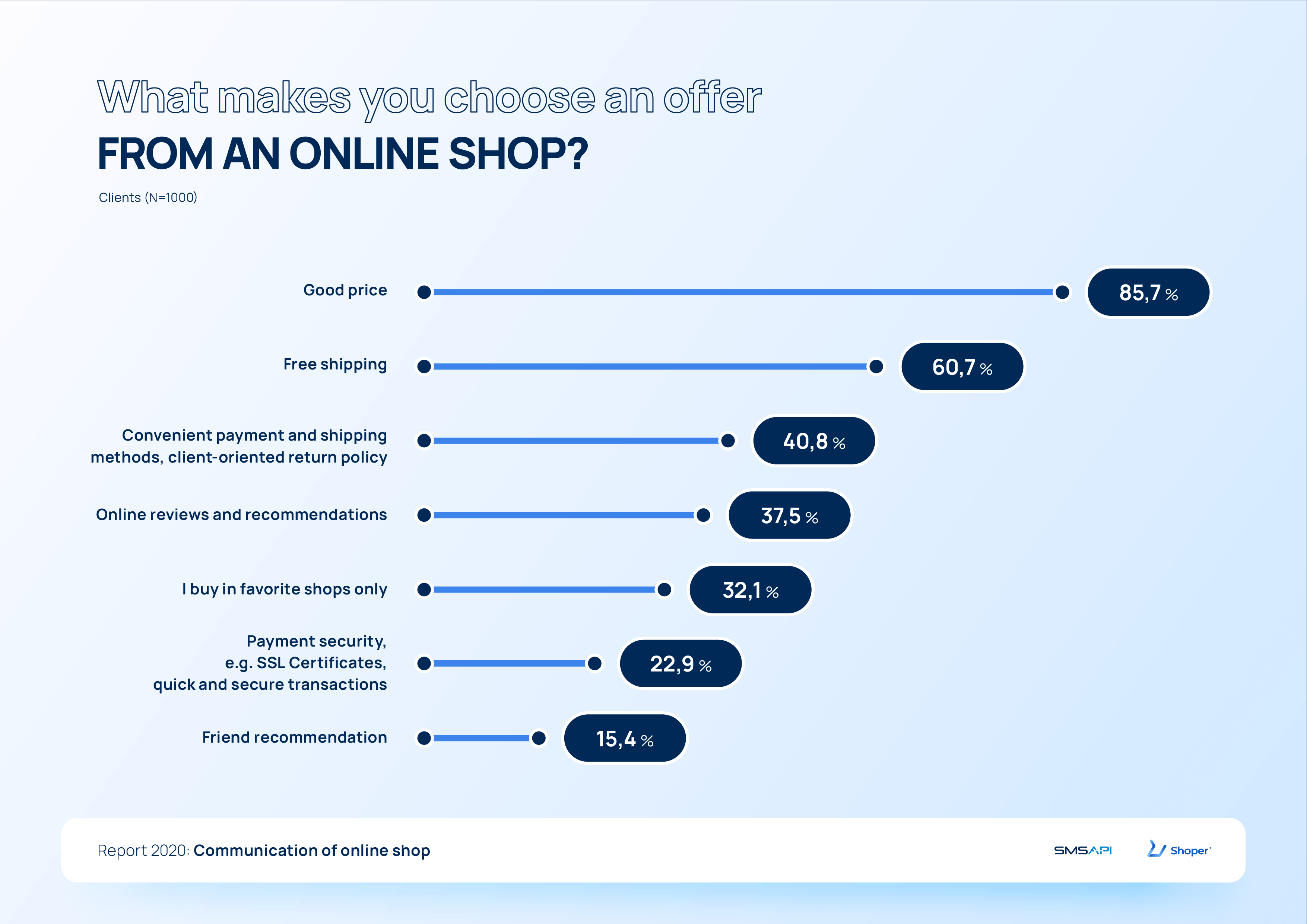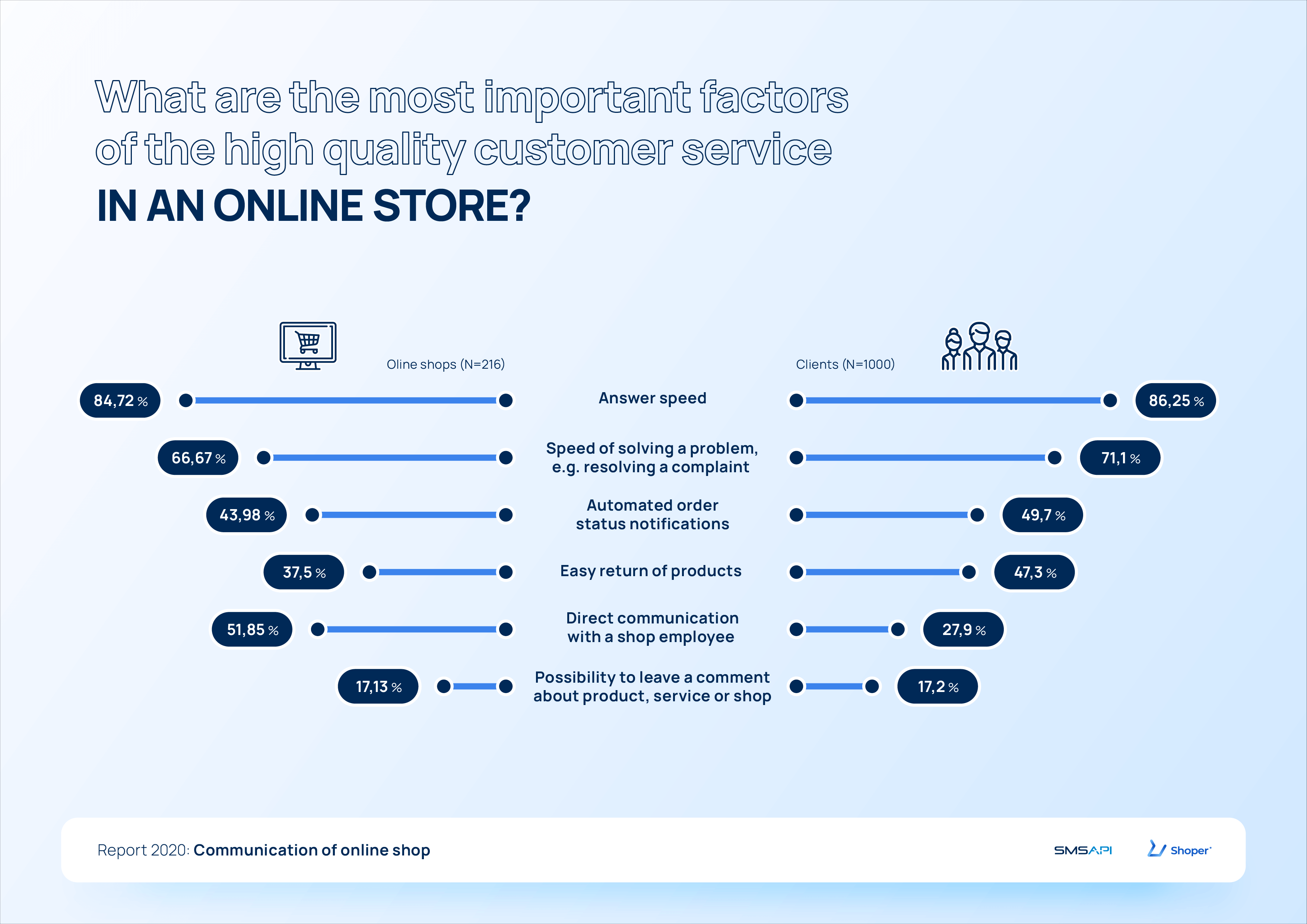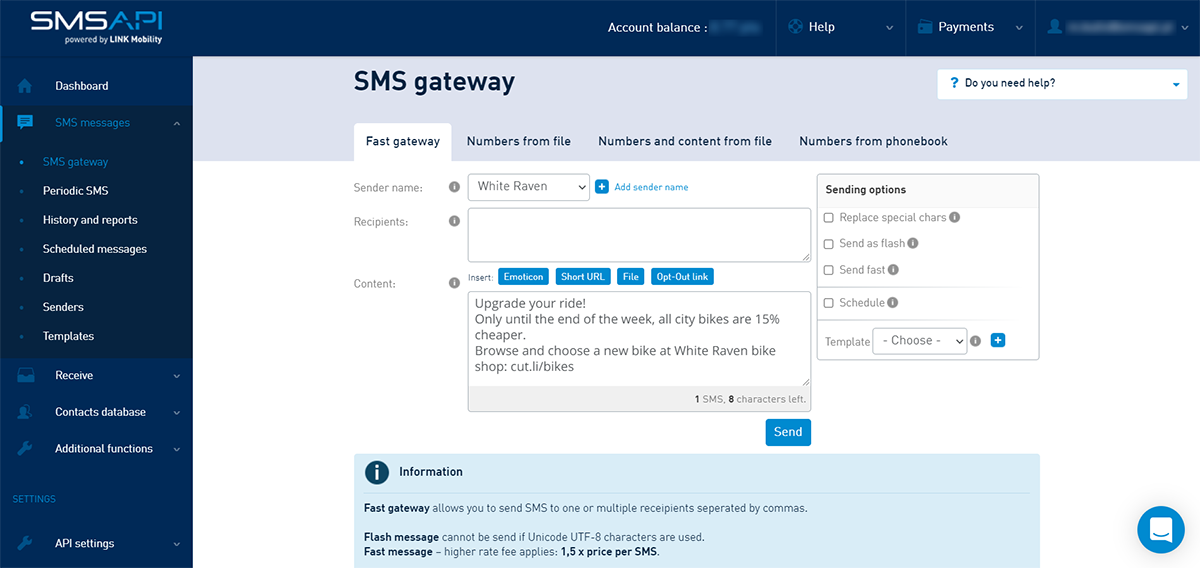SMS Communication for E-commerce [2021 Guide]
Written by
Editorial TeamPublished on

This guide will lead you through the basics of SMS communication for e-commerce. You will learn about the most important applications of text messaging in online business and how to implement them, as well as means to optimize your SMS campaigns and databases.
A brief history of texting
Bulk text messaging is a bottom-line tool of e-commerce, and so it is often overlooked as not on par with modern technology. This is bad, and mostly for those choosing not to use it. SMS communication brings profit for companies selling online. Furthermore, it helps to maintain engagement and serves as a customer service channel. Certain qualities make it unique, to name a few: offline availability, high speed and exceptional open rate. Enter the SMS communication for e-commerce.
The Short Message Service has been created to deliver quick messages from GSM operators about outages, changes in pricing and so on. In 1992 one of the engineers sent the very first personal text with holiday wishes. As a side note, the message was sent from a computer.
Soon after texting became the most widespread medium of personal communication. It gave birth to emoticons and set the standard for the next generation of communicators. Growing popularity of online chats like Messenger, WhatsApp, WeChat etc. pushed text messaging back to business embraces.
The life cycle of SMS
Application to person (A2P) -> Person to person (P2P) -> Business to consumer (B2C)
One may say that is made a full circle, from notifications to personal chat and then back to automated messaging. Nevertheless, SMS is a default channel available on all phones with active SIM cards.
Companies around the world send billions of text messages each year. A big bunch contains information about parcels, shipping and payment. Most brands use it also for marketing and interaction with their customers’ base. And while a single text message can be up to 160 characters, with no images or other media, it has an edge over newer standards.
Advantages of SMS communication:
- available by default on every mobile phone;
- faster read time (average of 5 minutes);
- higher open rate (around 98%);
- one inbox folder for all incoming messages;
- works offline even with a very weak network signal;
- numerous business applications.
Outbound and Inbound SMS messaging
Although we sent SMS back and forth when talking with each other, business SMS communication is often considered a 1-way only channel. In fact, there’s nothing easier than receiving SMS online. All you need is a 2-way SMS number. And so, SMS are meant for both inbound and outbound business communication.
This brings us to the first major decision when implementing SMS services in e-commerce: how and why do you want to engage with your audience? The answer defines suggested tools and applications.
For example, for the most popular SMS notifications, a simple branded SMS would be enough. It’s one of the basic and free tools of the bulk SMS platform like SMSAPI. How does it work? Instead of texting your customers from a random, unknown number, you can replace it with a selected name, e.g. company or campaign name. Important bit: GDPR requires you to get conscious consent from each client you want to write to. We’ll get back to customer databases building and optimization later on.
If you’d like to talk with your customers, you will have to acquire or rent the short code (special 4- or 5-digit number) or the long code (regular length number). Your SMS communication provider will help you with it. What’s interesting is that since the customer begins the interaction, you don’t have to worry about the beforementioned GDPR rules. Just remember to include it in your policy privacy.
SMS marketing for e-commerce
Bulk SMS campaigns are an effective marketing tool, but what really makes them shine is the relatively low intensity of sales-oriented messages. The niche stays (almost) vacant, yet more and more brands turn their gaze away from channels overflowed with offers, promotions and CTAs.

Database for mobile communication
The high-quality customer database is a key to cost-effective marketing, as you cannot send any message without GDPR-compliant consent from the client. The rules are identical to those regarding e-mail or any other form of communication, yet brands are reluctant to use this not-so-new channel. And that’s perfectly fine when you consider how low is the competition.
What makes a database high-quality? Certainly, the way you collect it. The best place to invite to SMS subscription is right after purchase or account creation. Successful shopping is associated with positive emotions and trust, that is why you should use this moment to reach out asking for consent to SMS communication.
SMS marketing consent example
I consent to the processing of my personal data for marketing purposes. The administrator of personal data is [COMPANY NAME], with registered office in [ADDRESS]. The data will be processed for marketing purposes via SMS. The Service Recipient has the right to access and correct his data and the right to demand discontinuation of processing as well as the right to object to the processing of data for the above purpose.
You should explain in a friendly yet informative way of speech what you are going to send, how often and… how to unsubscribe. Transparency goes a long way in relationship building and brings better leads to work with later. Refrain from using invasive tactics like navigation-blocking overlays, they’ll only make the users more eager to close the shop’s tab. If the clients are aware of the messaging rules, they can make a better decision whether they want to receive the communication. And once again, that’s alright! Your aim is not quantity but quality! Since you are paying for each sent message, it’s actually more cost-effective to contact only those with the highest chance of a conversion.

The most dreaded part of SMS communication – collecting contacts is not that hard. To make the channel more attractive shops often bait consents with a welcome discount or free shipping. For many, the latter is enough to pick a shop among others. Use this to your advantage when planning a communication strategy.
SMS customer service
A timely SMS campaign is fuel boosting your sales. At the same time, companies selling online use text messages to inform about a purchase and other important processes. Such messages are considered an integral part of e-commerce and are exempted from GDPR rules regarding marketing communication. Still, they should be included in the privacy policy of the shop. Automated SMS serve two main purposes: notification and authorization.
SMS notifications
Majority of online shops use e-mail as a default channel for order and payment status messaging. E-mails are the golden standard of e-commerce, true, but their popularity is at the same time their main drawback. Inboxes are filled with business communication. Situation is even worse when you add all promotions and offers that are delivered via this channel. It’s easy to miss that one important piece of information.

This is exactly why some companies use automated text messages to bypass overflowed e-mail channel. SMS are more reliable when it comes to reaching clients with timely notifications. Nevertheless, you should be careful when setting up automated messages. Pick one channel and stick to it, so you won’t spam your customers with the same message in multiple places.
Most e-commerce platforms offer ready-to-use plugins or addons that allow integration via SMS API (scroll down to read more about it). All you need is an account in one of many bulk SMS platforms. Be sure to choose one that has direct agreements with GSM operators, otherwise, your messages might get lost during delivery or be greatly delayed.
SMS authorization
SMS notifications are very similar to the text messages used for verification. SMS two-factor authentication (SMS 2FA) is another layer of protection for your customers and you, the admin. By separating channels of delivery, you make sure that customers’ data is more secure. Even if they lose access to the account, it’ll be retrievable with SMS authorization.

2FA SMS is commonly used by big and small companies alike. Check your mobile phone and see how many authorization codes you receive each week. Just to name some: Uber, Microsoft, Tinder and Booking are all using text messages to send verification via SMS. The SMS traits make it perfect for the role: it’s lightning-fast, reliable and operates independently from the internet connection. Keep in mind that this feature is not exclusive to the biggest players. Every company can implement SMS authorization as a layer of security.
Link in SMS – how to measure the effectiveness of SMS marketing?
You don’t have to be connected to the internet to receive or send SMS on your phone, still, they can link to websites and files online. And to make things easier, most inbox apps make URLs clickable.
Links are the bread and butter of SMS marketing, and there’s so much more to it. The whole trick is in using shortened links. Instead of sending normal, often long addresses, I suggest preparing them for each campaign individually. Firstly, think about how you are going to measure the effectiveness. One way to do it is by adding UTM parameters.
So, go to Google Campaign Builder and paste your address there. Fill in all fields that you are going to use. If you don’t know about UTM parameters, don’t worry there’s plenty of tutorials that will help you to start. Copy created a link to the shortener of your choice (e.g., a Bitly alternative). It’s best to use the one integrated with your mass SMS platform. Keep in mind that if you are using an integrated shortener (or one with a user account) you can always edit and delete your links. You have also some basic statistics there, like the number of clicks, devices and time of interaction. Shorten the link and et voila, you got yourself your first short URL with UTM parameters!
Video tutorial UTM parameters in SMS campaigns
Why bother will all of this instead of using regular links? The UTM parameters allow you to monitor traffic incoming from the source, in this case, from your SMS campaign. You can access the data directly in Google Analytics, so you’ll be able to monitor the results there. Alas, it’s impossible to check the open rate of SMS without a second step like a reply or website visit.

Furthermore, short links usually look better, and they are… short! Remember that each text message is limited to 160 characters, so you do want to reduce the number of characters of the link. And trust me, 3-, 4-lines long links are not exactly enticing to click.
Links fill one other gap of text messages. There’s no technical way to measure the read-rate of sent messages – the standard does not support it. You need a second step like a reply or website visit. With links and enticing copy, you can compare the amount of sent SMS with clicks, used coupons or replies to calls to your call center.
How to implement SMS communication in e-commerce?
Since you already know the basics of mobile marketing and SMS notifications, you can move on to the next step. Integration of SMS communication with e-commerce platform is, in most cases, an easy thing to do. SMSAPI, or another bulk SMS platform of your choosing, is already integrated with all most popular e-commerce systems like WooCommerce, WordPress, Magento, etc. You can check the full list of available integrations. If you didn’t find what you’ve been looking for, you can use Zapier or contact us for further information.
Start with registering an account at SMSAPI. Remember to fill in your company details, so we’ll be able to quickly verify your account, then you’ll be able to register your sender name and, if you need it, 2-Way SMS number. Next, go to your e-commerce platform and navigate to plugin or add-ons menu. Select SMSAPI and follow the installation instructions. Type in required credentials and you are ready to go!

Michał Kuliś – content marketer at SMSAPI responsible for creating texts, scripts, and other materials for online and offline publications. An avid fan of photography, animation, board games and trekking.


